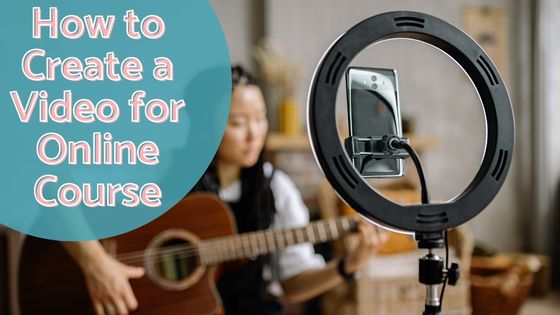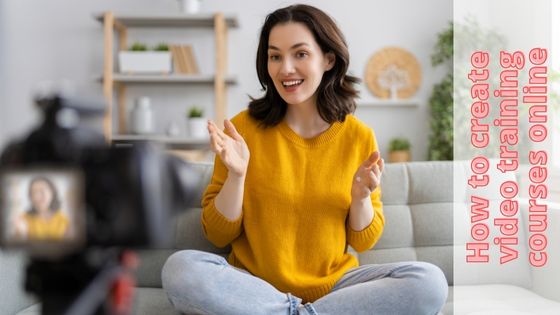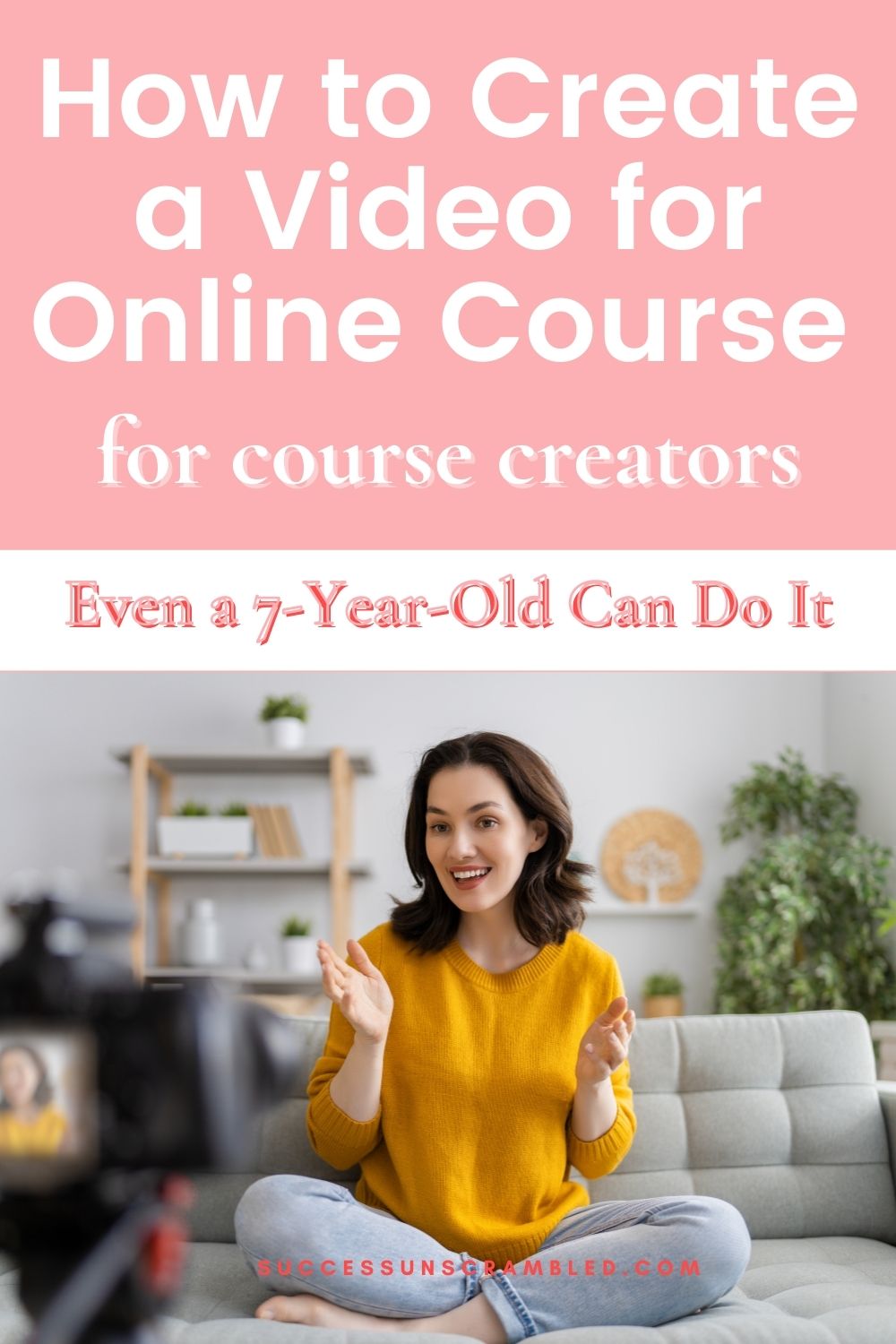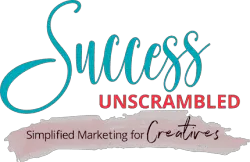Podcast: Play in new window | Download (Duration: 39:51 — 55.3MB) | Embed
Subscribe: Spotify | Amazon Music | Email | TuneIn | Deezer | RSS | More
Margaret sat at the kitchen table wondering how to create a video for her online course.
Ever since she experienced an online program a few years ago, Margaret got the course creator bug.
She realised how much value she could add to the lives of her potential students.
With the emergence of popular social media apps: TikTok, Instagram reels, Facebook reels, Youtube shorts– there’s a key underlying attraction and all signs point to video content.
Let’s face it, video is king now. Even if we didn’t want to jump on that train, it’s a take-it-or-lose ROI situation now. Selling anything is directly related to how well you present the service or product.
Although informing through a blog post is useful, numerous people prefer watching a video instead. Thus, the boom in online learning.
At first, the video freaked me out. How will I keep up with the quality, the lighting, the tone, everything? What goes into a high-quality, high-converting video and how do I get there?
I’ve invested hours upon hours in building out my video content so I can let you in on all the industry tricks of the trade. Grab your phone or DSLR, and let’s get filming, crew!
In this post, you’ll learn everything from reaching your target audience to identifying the right tools to make your work easy, and how to position yourself as an expert in your field.
It’s completely possible to make money as a course creator without any teaching experience.
As long as you have adequate knowledge of a subject, you can create expert video courses by following these painless steps.
Tag along as we take a deep dive into the subject.

First, Why Should You Create Online Courses?
The short answer here is impact, passive income, a wealth of knowledge, and flexibility. But, the freedom that comes with being a course creator is unparalleled– plus sharing your passions with others is always an exciting venture, isn’t it?
Create an Online Course to Impact Lives
Do you ever feel deeply satisfied whenever you help someone? That’s a sign that you’ll do well as a content creator. Your content can really make a difference.
The major reason for educating people is to impact their lives in a positive way. Teachers create a lasting impact on their students’ lives and can really shape and influence people in powerful ways.
The internet has made it easier than ever to teach local and international students. Create a course in California that’s accessible to learners in India, Turkey, Europe, and more!
You no longer have to meet people physically to make positive changes in their lives. Simply by producing excellent course content, you have the opportunity to make someone else’s journey smoother.
Tell your progress story to guide others as they climb the ladder. Someone out there needs the knowledge that you have; dispense it. Sharing your skills and expertise will have a greater impact than you might be able to imagine.
Create an Online Course for Passive Income
As of late, the entire world is experiencing inflation, which means having one stream of income is not enough to keep you financially stable. The ultimate goal for anyone in the 21st century is to make money while you sleep or at least have multiple sources of income.
Turn your passions and knowledge into passive income by creating a course that up and runs itself after initial development. Before, you were only able to access your local market to teach in-person classes. Now, the market is worldwide.
Create an Online Course for Flexibility
Online education has made it easy and convenient for entrepreneurs to make money doing what they enjoy from the comfort of their homes. We no longer need a physical location to create a business.
You can make your own video course at your own pace without any pressure. This allows you to own your time and manage it as you deem fit. If you’ve ever worked a 9-5, you know what I’m talking about.
Creating a complete guide on your preferred subject matter allows you to take breaks and spend ample time doing whatever it is that feeds you. Since you have the flexibility, you’ll have time to delve into hobbies and pastimes that you’ve previously ignored.
Create an Online Course to Concrete Personal Branding
Building a personal brand is essential for any expert who wants to stand out among the crowd.
Creating a video for online courses allows you to leave an unforgettable impression on your audience and makes your face easy to remember. Not to mention, videos reveal your personality more than text or imagery ever will!
You can transfer this audience to your social media platforms and interact with them there or create an email list and drive up customer/user loyalty.
When past or present students need assistance in their business, they’ll reach out to who they remember first– YOU!
This provides the opportunity to upsell and assist others in producing better results for their business.
Long story short– branding equals visibility and awareness which equals higher ROI, enforced customer loyalty, and scaled online presence.
Create an Online Course With Little-to-Zero Investment
Anyone who says you need to shell out thousands to build an online course is simply gatekeeping. All it takes is the right tools and proper direction to get it right, the first time.
Online learning eradicates the need to spend on printing course materials, creating an ideal environment for your students, and the costs of running a physical school.
Instead, you can leverage online course platform resources to create the perfect environment for your students to learn quickly. Most platforms have a free version that you can use without worrying about fees. The paid version is affordable and helpful since you’ll get your money back.
Create an Online Course Because Videos Are King
If you’ve ever considered releasing an e-book instead of a video; stop that thought. Video is the way to reach people in this day and age.
According to WordStream, 68% of customers prefer watching videos to using other forms like ebooks or infographics. With the amount of time users spend daily on social media, this isn’t surprising.
Create an Online Course To Generate Leads
Are you trying to gain more customers and generate leads for your business?
Learning how to create a video for an online course can help you achieve such results.
Once people perceive you as an authority in your niche, it opens doors for you to become a leader, appear on podcasts and interviews, and eventually gain traction in your field.
People are always looking for experts in particular niches to help them with business problems. Once you position yourself in a value-delivered role, you can upscale your business.
Now, How Do Different Video Formats Work for Online Courses?
Before learning how to develop online courses, it is essential that you’re aware of the different video formats that exist. It would help to familiarize yourself with them so you can make a perfect choice.
If you’re not tech-savvy, I totally get it. Snag a virtual coffee and chat with me, and I can answer any questions that arise in the following discussion.
Number 1: Screencast Videos
This video format involves recording your screen and accompanying it with a voiceover. You can decide whether to show your entire screen or just a part depending on what works best.
Most online course creators use this video function to walk students through every step they take. This way, students can easily imitate it to get the same results.
You should splice screencast videos with a presenter video for variety’s sake.
Screencast videos work best for courses that teach testing new software or products, setting up a new platform, building out funnels and much more.
Your potential customers will find this super useful and it saves them the trouble of having to figure out how a computer system works.
Number 2: Talking Head Videos
A talking head video requires a presenter or subject matter expert that is comfortable speaking to the camera.
The instructor either takes over the full screen or remains at the side so slides can be shown to students.
If you don’t have props, it is a good idea for you to use talking head videos for a start. All you really need is a good camera, a distraction-free location, video editing tools, and a script.
Number 3: Animated Videos
Animated videos are popular for their way of bringing a fun and exciting perspective to the learning experience. If you’re looking for a way to make complex topics much easier, you can use this format.
These videos use graphics and text to pass a specific message to an audience.
Some popular examples of animated videos include animated infographics, whiteboard animations, cartoon-style animations, character-based animations, and 2D animations.
You can hire a designer to help you produce animated videos from your course content if you prefer this format to the rest, as most online course platforms don’t offer this media tool.
Number 4: Interactive Videos
Interactive videos are relatively new in online education.
Interactive videos guide students through the course by clicking buttons to navigate to the following steps. Students must make decisions or answer questions correctly to be prompted with the next step.
This format works well for adapting to different scenarios and allows students to make decisions in real time.

Which Video Format Is Best for Your Business or Course Offering?
All four video formats are used for unique reasons. For certain niches, it may be better to have a guidable course setup, like interactive videos.
For coding or tech, a lot, of course, facilitators use talking heads or screen sharing so students can follow along with the exact layout of the site.
Think about what you would prefer as a student in your niche, what avenue provides the best opportunity to stimulate learning?
Five factors to consider when choosing a video format for your course are:
The Budget
Creating a talking-head video is the most affordable option as it requires minimal equipment.
However, if you want to create animated videos or interactive videos, you’ll need to invest more cash in the visuals.
Visual Knowledge
Although you can create expert videos like talking-head videos without much knowledge of visuals, knowing what works best for what content will make your course outperform others.
Technical Knowledge
Some video formats have complexities requiring technical knowledge to create a successful online course.
For example, to make animated videos or screencasts about how computer software works you’ll need technical expertise. Then, you can fully explore the video formats throughout your course that will heighten the learning experience for your students.
The Topic
The topic of your online course is an important factor that influences the type of video that will work best for you.
Take into consideration the main objective and outcome of the course.
If you’re walking your audience through the process of using new software, you cannot avoid using screencasts.
If you’re dealing with a dull subject that requires some excitement, use animated videos to make it simple yet engaging.
A good way to decide if this video format is perfect for your course offering is to conduct baseline competitor research by scanning reviews. Check the negative reviews to see if there are any mentions of how the course could be improved and then deliver.
Preference
Select the format you’re most comfortable with to ensure your videos come out looking their best.
If you’re able to budget in a video editor, then you can experiment with formats outside of your comfort zone, which might end up working better for your course niche.
So, How Can You Produce Appealing Videos for Your Online Courses, Without Being a Professional Videographer?
Do the words, “video production,” ring any bells?
What is video production anyways?
To put it simply, video production deals with the entire process of making a video, from ideation to execution. This includes pre-production, production and post-production.
A, B, and C of video before and after. You’re seeing the online course idea and script through the pipeline until completion.
Even though you’re not plotting a major motion picture, it’s vital you flow through every step of the video process to ensure the final product comes out perfectly.
You can liken the process of creating online course videos to that of building a house. Builders always have to start by preparing the land, starting the foundation, and building the blocks till the point of roofing.
There’s no way you can jump one step before going to the other, the same way with creating an appealing online course video.
Remember, if you create a quality video, you won’t need to jump through hoops again and again to fix the weak spots. Video production can be as smooth as four, basic steps.
4 Steps for Producing Captivating Videos For Online Courses
You need to create online video courses that will grab your audience’s attention and keep them coming back for more.
The purpose of your online course can be defeated if the videos you create fail to resonate with your viewers.
Instead of testing random suggestions, here are my four tried and tested steps towards a flawless course creation process.
If you have any questions or need help with the content planning and video suggestions, let’s hop on a call and discuss what suits you best!
Step 1: Planning
Remember that popular saying, “if you fail to plan, you plan to fail?”
Planning is everything.
As a creator and expert in your niche, it’s your job to provide the quality and valuable information that customers are willing to pay for. When you fail to strategize or think through your logic and script, people are going to notice.
Before you start filming, ask yourself:
What Are Your Expected Learning Outcomes?
When your students have finished taking your course, what do you want them to achieve?
For example, if you’re teaching them how to use a particular software, you need to determine how proficient you want them to be after taking the course.
Knowing what your students stand to gain will offer you a clear direction on what you’re supposed to produce.
What’s Your Topic?
When choosing a topic, it must be one that you can handle confidently.
Choosing a topic you cannot handle will affect your reputation and reduce your capacity to earn passive income. This may be obvious, but it’s a needed reminder.
Who Is Your Target Audience?
Who and where are important factors.
The who is who you see taking your course and gaining something from it.
The where is where in their learning journey are your target students. If you’re targeting people with advanced knowledge of a subject, it will be a waste of time for you to start your course from scratch.
Instead, you can move directly to the significant aspect you’re handling with a summary of the basics.
Step 2: Preparing
After you’ve drafted a solid plan for your video courses, the next step is for you to start making moves.
How Do You Create an Outline?
Every outline or lesson plan begins with the research stage.
Know and study the ins and outs of your niche to determine a structure for course delivery. Without a good structure, you can miss out on some crucial aspects or even talk about the subject because there’s no clear direction.
You can search for blog posts or videos that have already been created around a specific topic to determine the pain points of your target audience.
The research will help you identify the gaps in the materials already created and see how your course can fill them. Afterwards, you start creating a sketch of what the course will look like.
For visual learners and teachers, I recommend using a storyboard to help visualize a sequence of the information provided.
How To Prepare a Video Script?
When training for improv, professional comedians practice filling or not filling the quiet spaces with common stutters like “um,” “ah,” and “like.”
In fact, throw these words out of your vocabulary– they’re dead to you now!
A script mitigates all these throwaway words because you know exactly what you want to say, and how you plan to say it.
Read your script aloud to ensure that it flows well. If you don’t plan on being the voiceover for your content, have your presenter read it out once before filming to double back on content delivery.
Don’t neglect spacing and timing. Details are registered differently when you place important information together.

What Equipment Do You Need?
A course builder is only as good as the tools used for creating the videos.
The right equipment can make a difference between a successful online course and an unsuccessful one.
A good camera, tripod, and editing tools make your videos look polished and intentional.
Check out my list of affordable tools, I’ll link to it on my site or you can access it from my podcast notes.
There are also affordable tools, such as Adobe After Effects, that work effectively for animation, graphics, and visual effects.
Free tools like Cam studio can help your videos stand out if you’re starting. Some online platforms already have built-in tools to make your work easier.
- Recording Space:
Learning is majorly influenced by the environment, so you must prepare your recording space before creating videos.
Making videos in a chaotic environment makes the video quality poor and diverts your students’ focus. Here are a few factors to consider to improve your space:
- Background:
You need to decide the colour of your background and use a backdrop from your screen to settle it once and for all.
- Quietness:
Background noise affects the audio clarity and makes it difficult for your audience to pick the needed information from the online course. You can choose an isolated space in your house or shoot when you’re sure there’ll be no interruptions or noise.
Hack Tip: If you are using your laptop to record video content grab a copy of Krisp to block out all background noise.
- Composition:
Your face has to be adequately positioned at the centre of the screen for better presentation or a little bubble at the side works as well. When creating screen recordings, you must be careful that the whole information is covered on the screen.
Since your students will learn from your screen, you must clear out your computer and close unnecessary tabs. You don’t want notifications popping up in the middle of creating a great course.
Step 3: Creating:
Now, you can move to the most interesting part which is creating. However, you have to be careful, so you’re not overly excited to the point you miss out on the right way to create compelling videos for online courses.
Recording Your Video:
Learning how to record an online class is slightly different from other types of videos. It requires a level of seriousness and a content creator has to gain the trust of the target audience within a short time.
It’s normal for you to feel shy in front of a camera. Some of the best instructors still feel that way before recording.
You want to create a consistent tone throughout the video and show some personality, if it is a talking head video, to create a human effect that will keep your audience engaged. Make sure you watch yourself repeatedly to know the areas that require adjustments.
While you’re practising, try not to be harsh on yourself. Always remember that you’re making progress.
Try imagining that you’re teaching your closest pal. Using that approach will make you comfortable in front of the camera.
Another aspect you must watch out for is your body language. Your body language says so many words that your mouth doesn’t. You want it to sync with the message you’re trying to convey.
A correct posture creates a powerful effect on your viewers. It must communicate confidence and show that you’re sure about what you’re talking about. If you lack gestures or you’re leaning all the time, it defeats the purpose of your online video course.
Editing Your Video:
Editing is crucial to creating an appealing video for your target audience. This video content creation process requires that you cut out every background noise and any mistakes that can affect the delivery.
Thorough video editing will help you eliminate mistakes and trim the video to the ideal length of an online course which is no more than 20 minutes.
Ensuring that your online course’s audio and video quality is top-notch can be daunting. Recording your video directly from an editing software like the iSpring editor can make your work easier.
Also, editing your videos in small batches will make the task easier, and you’ll be able to focus on its coherence and sequential flow.
Editing also involves including audio and video effects to make the video more appealing. Adding music or a voiceover to your online course videos can make them more fun and engaging.
Music is one of the elements that make TikTok videos popular; viewers love it. You can also include animations and visuals to make the course less rigid.
In addition, transitions are equally essential to video editing to ensure a seamless flow between numerous scenes. Once you’ve figured out all these, you’re ready to start distributing.
Step 4: Delivering
Even if you create a compelling course, if you’re oblivious to the right ways to deliver it to your audience, all your efforts will be wasted.
Once you’re done creating, the next step is to export the videos so you can easily upload them to your preferred channel. Depending on what suits you best, you can convert the file to an MP4, MOV, or GIF file.
The next step is hosting. You need a platform that easily makes your videos available to your viewers. Platforms like YouTube, Vimeo, an online community (Circle) or a Facebook group can help you distribute your online course.
It is important to note that in order to upload a video to YouTube you must first create a YouTube channel.
If you have a functional website with lots of visitors, you can use WordPress for hosting. Another option to consider is hosting your videos on online platforms such as Udemy, Lynda, Thinkific, and others to gain a wider reach.
5 Tips For Creating High-Quality Videos For Online Courses
Creating an appealing video for an online course is not rocket science. With the right hacks up your sleeve, you can keep your audience engaged from beginning to end. Here are a few things to look out for on how to record an online course:
1. Pay Attention to the Video Length
Students are naturally intimidated by long videos. If you will catch their interest, you must learn how to pass across much information within a short time.
Once your video is over 20 minutes, you should make efforts to reduce the length, so you don’t scare your target audience.
However, you also have to be careful, so you don’t remove the crucial aspects that will give your students an in-depth perspective on the topic.
2. Review Your Script
Your script is the most powerful tool for creating a successful online course. This is why you must review it thoroughly for grammar errors and logicality.
A review will help you gain more confidence when recording the course because you know the content has been thoroughly scrutinized.
Another way to make it easy is to give the script to someone you trust to help you read through it. Getting a fresh pair of eyes to check it will make your work faster and more effective.
3. Practice
If you’ve never had experience creating videos, you need lots of practice to avoid coming off as an amateur in your field.
You can start by presenting your course content in front of a mirror so you can study your facial expressions, body language, and posture before you use a camera.
Rewatching your screen recording multiple times can also help you get more comfortable in front of a camera.
Implementing these hacks will make your content delivery more natural. Also, it will make your audience feel connected to you and that’s the effect you want.

4. Video Lighting
If you’re creating a talking head video, you need ample light to create the right effect. Most times, relying on natural light can slow down your work because you’ll only be able to shoot during the day.
However, with a ring light, you can create tutorial videos at any time that suits you. Proper lighting will help your students see you clearly and create a more engaging effect.
5. Audio
What’s the essence of a nice-looking video if your viewers cannot hear you clearly? You will only end up confusing your audience. Create a test recording to listen to the audio quality before you start.
It can be devastating when you’ve created multiple videos only to find out later that the audio quality is poor. You should also consider investing in high-quality microphones and software to ensure it comes out nicely.
Conclusion
Knowing how to create a video for an online course can put you ahead of your competition. It comes with mouthwatering benefits that can help you level up your authority.
The best part, you don’t have to set up a standard studio to create videos which means you can make videos within your budget.
Creating videos that will resonate with your target audience requires a solid plan, preparation, creation, and delivery efforts to make it successful.
Although these steps are dead easy, it is necessary that you understand as a course builder that high-quality videos cannot be made haphazardly.
Hacks like practice can make a difference in the quality of your online course video and set you on a path of constant growth and improvement.
Following the steps provided in this article will help you start as a course builder and also guide you through the process of creating multiple profitable online courses.



2 thoughts on “How to Create a Video for Online Course [7-Year-Olds Can Do It]”
I love how in depth you went into this.
Stephanie, I’m so excited to hear that you loved it!🙌
Comments are closed.